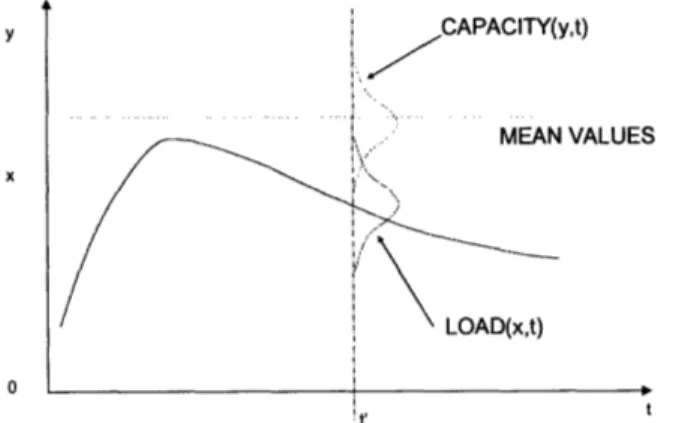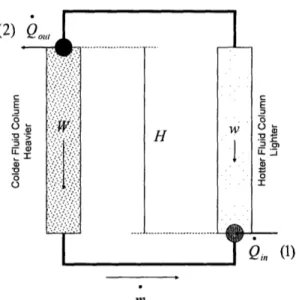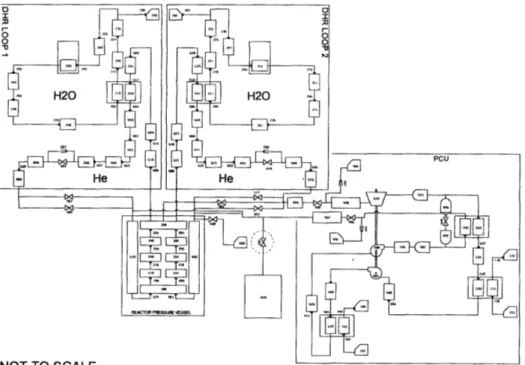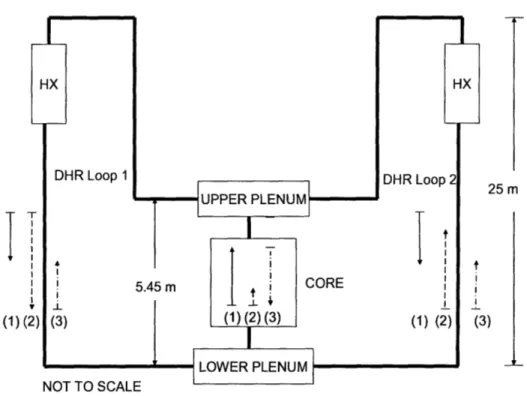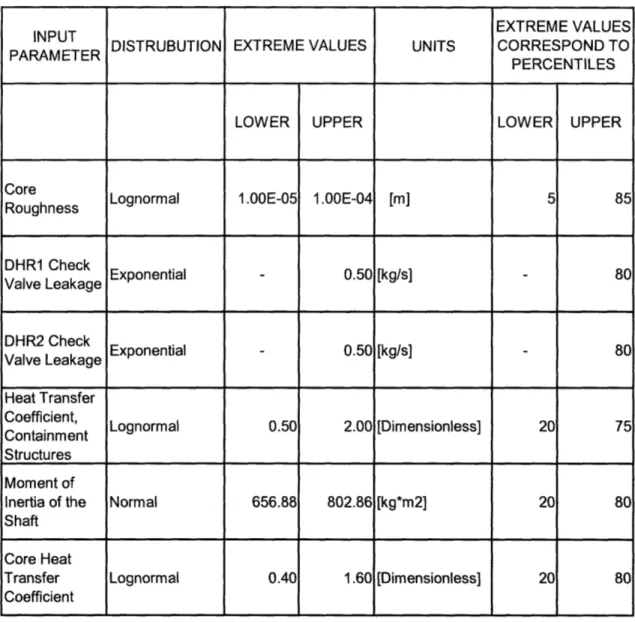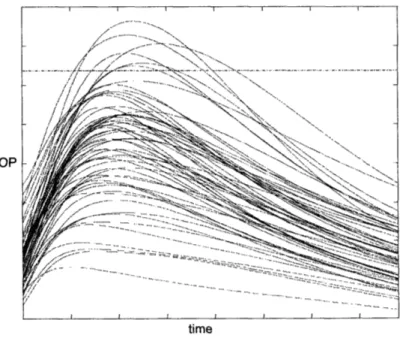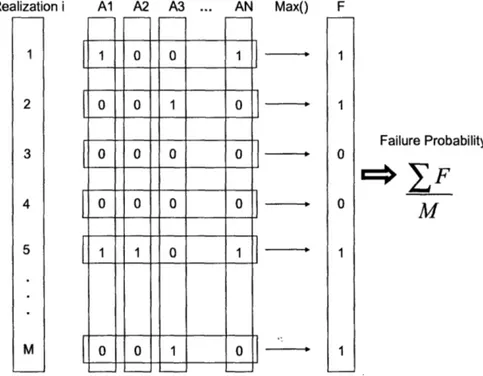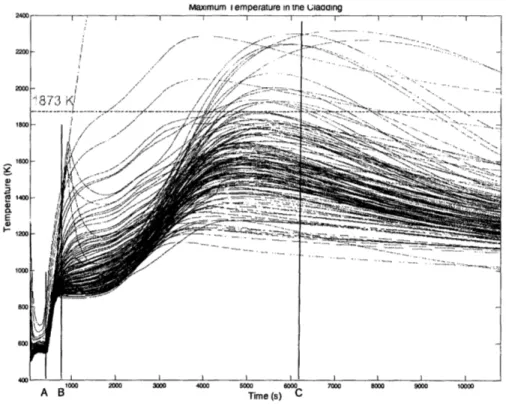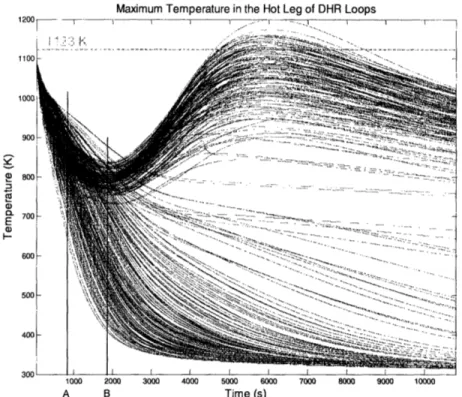CALCULATING FAILURE PROBABILITIES OF PASSIVE
SYSTEMS DURING TRANSIENTS
By
Francisco J. Mackay
Electronics Engineer
Academia Politecnica Naval, Chile - 2001
SUBMITTED TO THE DEPARTMENT OF NUCLEAR SCIENCE AND
ENGINEERING IN PARTIAL
FULFILLMENT OF THE REQUIREMENTS FOR THE DEGREE OF
MASTER OF SCIENCE IN NUCLEAR SCIENCE AND ENGINEERING
AT THE
MASSACHUSETTS INSTITUTE OF TECHNOLOGY
JANUARY 2007
@2007
Massachusetts Institute ofTechnology.
All
rights reserved.
The author hereby grants to MIT permission to reproduce
and to distribute publicly paper and electronic
copies of this thesis documert ip whole or in part
in any medium now known
t
ereafter created.
Signature of the author: ___
Departmei-oNuclear Sciennce
e
oogy
YL~afu
Ja u ry
0
Certified by:
.
.,
George E. Apostolakis
Professor of Nuclear Science and Engineering
Thesis supervisor
Accepted by:
.
..
-Ab
Pavel Hejzlar
.
PrinciRal Research Scientist
Accepted by:
MASSACHUSTS INSTITUrMJ OF TECHNOLOGYOCT 1
2
2007
LIBRARIES
I
Jeffrey A. Coderre
Associate Professor of Nuclear Science and Engineering
Chairman, Department Committee on Graduate Students
CALCULATING FAILURE PROBABILITIES OF PASSIVE
SYSTEMS DURING TRANSIENTS
by
Francisco J. Mackay
Submitted to the Department of Nuclear Science &
Engineering on January 23, 2007 in partial fulfillment of
the requirements for the Degree of Master of Science in
Nuclear Science and Engineering
1. ABSTRACT
A time-dependent reliability evaluation of a two-loop passive Decay Heat
Removal (DHR) system was performed as part of the iterative design process for a
helium-cooled fast reactor. The system was modeled using RELAP5-3D. The
uncertainties in input parameters were assessed and were propagated through the model
using Latin Hypercube Sampling. An important finding was the discovery that the
smaller pressure loss through the DHR heat exchanger than through the core would make
the flow to bypass the core through one DHR loop, if two loops operated in parallel.
This finding is a warning against modeling only one lumped DHR loop and assuming that
n of them will remove n times the decay power. Sensitivity analyses revealed that there
are values of some input parameters for which failures are very unlikely. The calculated
conditional (i.e., given the LOCA) failure probability was deemed to be too high leading
to the identification of several design changes to improve system reliability. This study is
an example of the kinds of insights that can be obtained by including a reliability
assessment in the design process. It is different from the usual use of PSA in design,
which compares different system configurations, because it focuses on the
thermal-hydraulic performance of a safety function.
Thesis supervisor: George E. Apostolakis
2. ACKNOWLEDGMENT
I want to thank my wife for, without her support and care, this work could not
have been possible. To Prof. George E. Apostolakis, for his guidance, support, counsel
and for the most his patience. To Pavel Hejzlar, whose knowledge was always an
incredible source of light when walking through the dark paths of accurate simulation.
To Prof. Michael J. Driscoll, for being an unlimited source of ideas and support through
the whole process. Last, but not least, to Chris Handwerk, Mike Stawicki, David
Carpenter, Tyler Ellis, Giovanbattista Patalano, Edoardo Cavalieri, Lorene Debesse and
Rodney Busquim for their friendship and willingness to help me in so many ways. This
3. TABLE OF CONTENTS
A B ST R A C T ...
... . . . . 3
A C K N O W LED G M EN T ...
... 4
TABLE OF CONTENTS ...
... 5
TA BLE OF FIG U R ES...6
INTRODUCTION...
...
7
SYSTEM DESCRIPTION...13
A N A L Y S IS ...
19
7.1.
Mechanistic Model ...
...
.
... 19
7 .2 .
U n certain ties ...
24
7.3.
Uncertainty Propagation ...
... 27
7.4.
Failure Criteria ...
28
7.5.
System Failure Criteria ...
29
7 .6 .
R esu lts...
... ...
... 3 0
RISK-BASED DESIGN CHANGES ...
41
C O N C LU SIO N S ...
43
. R EFEREN C ES ...
. . . . ..
...
... 45
S APPENDICES ...
...
47
11.1.
APPENDIX A: RELAP5-3D NODALIZATION DIAGRAM ... 47
11.2.
APPENDIX B: RELAP5-3D NOMINAL INPUT DECK ... 48
11.3.
APPENDIX C: TABLE OF PROPAGATED UNCERTAITY...157
11.4.
APPENDIX D: UTILIZED ALGORITHMS ...
163
8.
9.
10
4. TABLE OF FIGURES
Figure 1. An example of load and capacity stochastic processes...8
Figure 2. Schem atic GFR system layout ...
13
Figure 3. Schematic of a natural circulation loop ...
15
Figure 4. RELAP5-3D Nodalization diagram of the system...19
Figure
5.
Possible flow patterns ...
23
Figure 6 Example of the output from an LHS uncertainty propagation...28
Figure
7
M ultiple Failure Criteria...30
Figure 8 Realizations for Maximum Temperature in the Cladding...31
Figure 9 Realizations for the Maximum Temperature in the Hot Leg of DHR Loops ....33
Figure 10 Leakage Threshold Effect (cladding failure) ...
34
Figure 11 Maximum leakage and HTCS Threshold Effect (structural failure)...36
Figure 12 Search for threshold effects (Failure Mode 1, cladding failure) ... 37
5. INTRODUCTION
According to the International Atomic Energy Agency (IAEA) definition, a
passive system is either a system that is composed of passive components and structures
or a system that uses active components in a very limited way to initiate subsequent
passive operation (IAEA, 1991). Of great importance are thermal-hydraulic systems
(T-H) that fall under IAEA Categories B and C. These are characterized by moving working
fluids either without or with moving mechanical parts, such as check or relief valves,
respectively.
Passive system reliability analysis has attracted increasing attention over the last
decade. The expectation that the overall plant reliability should increase by replacing
certain active systems with passive ones is based on the fact that unreliability of active
systems is due primarily to the unreliability of the energy source that is required for them
to perform. Passive system functionality does not rely on an external source of energy,
but on an intelligent use of the naturally available one (gravity), which is always present.
As the research in the field advances, the tradeoffs between passive and active systems
are becoming clear. Although the energy source is always available for a passive system,
it is normally weak. As a result, passive systems are much more sensitive to changes in
the surroundings than active ones (Pagani et al, 2005). In addition, the operators cannot
control passive systems the way they can control the performance of active systems.
Since the reliability evaluation does not depend on the availability of the driving
energy, a new description of the concept of failure is required. The concept of passive
(2003). It describes "failure" in terms of a "load" exerted during the perfornnance of the
system on its components and the "capacity" of these components to withstand that load.
An example of a load is the temperature at a certain point as the system operates. The
temperature limit of the material at that point above which damage occurs is the capacity
of the system. In general, both the load and the capacity are uncertain and may depend
on time (an example is shown in Figure 1). The probability that the load exceeds the
capacity is the failure probability of the system for that point in time. Two models are
therefore needed, one for the load and one for the capacity. In general, the capacity
model may be correlated with the load model. In other words, the capacity of a
component can be a function of its state and therefore time-dependent. An example of
this is the dependence of material yield stress on temperature. Therefore, if the analyzed
component is a pipe, the pressure required to break it is a function of the temperature,
which may vary according to the performance of the system.
y X CAPACITY(y,t) ... MEAN VALUES LOAD(x,t)
Figure 1. An example of load and capacity stochastic processes.
The following tasks need to be performed to evaluate the reliability of a passive
1. Identification of the components (points in the system) where failure may occur
and their respective loads and capacities. A component may fail in a number of
ways. Failure Modes and Effects Analysis (FMEA) and Hazard and Operability
HAZOP Analysis are methods that are helpful in identifying component failure
modes (Burgazzi, 2004).
2. Definition of component failure criteria, i.e., the type of capacity model that
should be used for each load determined in the previous task. Capacity models
may be in the form of deterministic limits (e.g., imposed by a regulatory
authority) or probability distributions based on experiments and/or expert
opinions.
3. Selection of sets of parameters (boundary conditions, system properties and initial
conditions) that affect the behavior of each load determined in Task 1. The
Analytical Hierarchy Process (AHP) has been proposed to help identify these
important driving parameters (Zio et al, 2003; Marques et al, 2005).
4. Development of a probability distribution for each parameter input to the model to
represent the relevant uncertainties. This is a crucial step and is normally done
based on experiments or expert opinions (Jafari et al, 2003; Marques et al, 2005;
Pagani et al, 2005).
5.
Propagation of the uncertainty distributions of the input parameters through the
models. Many techniques have been proposed to perform this step. They range
surfaces. A discussion on the advantages and disadvantages of each option is
presented by Marques et al. (2005).
6. Calculation of system reliability. The system is considered failed if one or more
of the failure criteria are met. This means that more than one component may fail
for the same system realization (Marques et al, 2005). The result of this
calculation is the probability of failure of the system.
These tasks provide the main structure of any passive system reliability
calculation. The list does not include tasks aimed at improving the quality and efficiency
of the calculations, such as early sensitivity analyses or iteration loops between tasks. A
more detailed description of these tasks is presented in (Jafari et al, 2003; Marques et al,
2005).
This work presents a detailed description of the time-dependent reliability
evaluation of a passive decay heat removal system after a Lost-of-Coolant-Accident
(LOCA). We emphasize the difficulties found in the process, propose solutions, and
describe the lessons learned regarding the design itself. Our focus is on uncertainties and
their propagation.
A preliminary design of a helium-cooled fast reactor constitutes the case study. It
is part of the MIT studies on a Gas-cooled Fast Reactor (GFR) design. The system and
its components were simulated using RELAP5-3D (INEEL, 2001). The entire system
operates as one passive system whose initiation is triggered by the reactor scram after a
The complete description of the reliability calculation is presented in Section 3,
where suggestions for design improvement are also given by identifying the input
parameters that are driving the failure of the system. Finally, conclusions on different
6. SYSTEM DESCRIPTION
The GFR design considered consists of a 600 MWth helium-cooled fast reactor
core inside the Pressure Vessel (PV), a Brayton power cycle within the Power
Conversion Unit (PCU), and two 50% Decay Heat Removal (DHR) loops (Figure 2).
The core is designed to have very low pressure drop to maximize the natural circulation
capability. Moreover, the PV, the PCU and the DHR loops are surrounded by a guard
containment with a high design pressure of 2 MPa (20 bars), so that, after primary system
depressurization, the final pressure in the guard containment would be high enough to
make DHR by natural circulation of helium possible. Each DHR loop is designed to
extract 2% of the reactor nominal power (12 MWth) at a backup pressure of 1.3 MPa.
QteafEmhgnpr
.... ... "qGuil lot~ge (- ' I.. -ýý %fiWGOI P Cbsed-A kYhCbsed-AMw WAS KIPr eMR& I IFigure 2. Schematic GFR system layout.
Each DHR loop consists of two separate circuits. The first is connected to the PV
through a coaxial pipe with the cold leg running in the outside. Heat is subsequently
loop delivers the heat to a pool outside the containment building. Check valves are
placed in the cold leg of the helium section of each DHR loop. The PCU contains a
Brayton power cycle with recuperator, precooler and intercooler. The shaft that is
propelled by the turbine provides energy to the generator and to the low and high
pressure compressors of the cycle as well. More details on the GFR system layout are in
Hejzlar et al. (2005).
As will be seen later, there are several parameters that are of importance for a
natural circulation loop to work properly. An intuitive review of the phenomenon gives a
good insight into the system's dynamics. Figure 3 shows a generic loop that is the
starting point of the discussion. Heat is inserted at point (1) and extracted at point (2).
There is no heat transfer at any other point in the circuit. When the fluid is heated at
point (1) its density decreases and it begins to flow up and forms the hotter fluid column
that is shown in the figure. At the same time, when heat is extracted at point (2), the
density of the fluid increases and as a result it moves down forming the colder fluid
column shown in the figure. The difference in weight (W-w) between the two columns is
the driving force that results in a certain mass flow running through the loop. The mass
flow is primarily determined by the driving force and the resistance that the system exerts
to the flow through pipes and fittings. To increase the mass flow then one can increase
H, the difference in altitude between points (1) and (2), increase the temperature
difference between the columns, or replace the fluid by one whose density change per
(2) C
E
D
0 "o -0 *0 Q5 0) (1) mFigure 3. Schematic of a natural circulation loop.
Assuming the loop is at steady state (which implies Qo,,
-
= 0), the rate at
which the system is extracting heat from the source is equal to
Q,,
[J/s]:
Q,,,
=m* Cp
*
AT
(1)
where
m
=
pVA
=
Mass Flow [kg/s]
Cp = Isobaric Heat Capacity [J/kg K]
AT = Temperature Difference between hot and cold legs [K]
p
=
Density [kg/m']
V
=
Velocity [m/s]
A
=
Flowing Area [m2]
Therefore, in order to extract more heat either the mass flow or the temperature
difference needs to be increased in the passive loop. Increasing the mass flow is
normally preferable because to increase AT almost always means to increase the
limit. Embedded in this short argument is the importance of the backup pressure. A
greater pressure means higher density of the helium and a higher mass flow through the
heat exchanger for the same fluid velocity, letting the system extract more heat from the
source, while keeping AT constant. Although not mentioned in the discussion above, an
increase in the density is also beneficial to the natural circulation phenomenon because it
reduces the friction factor along the loop due to reduced kinematic viscosity, therefore
allowing a larger mass flow.
A LOCA on the cold leg of the PCU was chosen as the initiating event of the
analysis. The system is designed to survive a 500 cm
2break, but it was evaluated for a
5
cm
2break that is much more probable (frequency: 10
-3per year) than a large break. The
sequence of events is as follows:
1. The cooling function is performed by the helium coming from the PCU
from the moment of the accident until the shaft with turbine and
compressors stops. During that time the flow coming out from the PCU is
divided into two streams at the point of the rupture: the first one goes
directly to the containment through the break and the second follows its
initial path to the core through the downcomer. How long the shaft runs is
a function of the size of the break. For a 500 cm
2break, the Brayton cycle
would work as such, propelled by the decay heat, for a period of time
ranging between 30 to 40 minutes. This gives enough time for the decay
heat to fall below the 2% nominal power threshold, so the DHR loops can
break. The shaft stops after approximately 10 minutes. The higher
density of the helium, sustained in time because of the small break area,
plus a smaller temperature difference across the core provide more
resistance to compressors and less energy is extracted by the turbine from
helium, therefore the reduction in shaft coastdown time. During this
period the PCU is cooling down the core and the check valves placed on
the cold legs of the natural circulation DHR loops are closed.
2. Once the shaft stops, the pressure difference is reversed and the check
valves open, allowing the natural circulation through the DHR loops to
start. Two parameters are important here: the pressure inside the PV and
DHR loop and the amount of decay heat that is being released at that
moment. For the case of a 500 cm
2break, the pressure inside the PV is
already equalized to that of the containment and the decay heat is below
the 2% nominal power threshold. Problems could arise, for example, if
the structures in the containment absorbed an excessive amount of heat,
therefore reducing the backup pressure required for natural circulation, or
if the shaft stopped when the decay heat was greater than 12 MWth. For
the
5
cm
2break, the dynamics are different. The shaft stops within 10
minutes of the accident but the pressure inside the PV remains high
enough to sustain a natural circulation capable to extract the decay heat
that is being produced. Nevertheless, when natural circulation through the
DHR loops starts, the temperature difference across the core is not
temperature begins to rise until it reaches its operating condition.
Meanwhile, the natural circulation is continually deteriorating by the
depressurization process that will eventually end about 30 to 40 minutes
after the accident. After that time the decay heat is below the 12 MWth
mark and, if the backup pressure is by then adequate and decaying slower
7. ANALYSIS
7. 1.Mechanistic Model
The mechanistic model simulates the dynamic behavior of the system given a set
of boundary and initial conditions and system physical properties (i.e., it is the "model of
the world" in PRA terminology (Apostolakis, 1994)). This model will be used to perform
sensitivity analyses and to propagate the uncertainties in the input parameters.
A complete model of the system was built using RELAP5-3D (INEEL, 2001).
RELAP5-3D is a thermal-hydraulic code developed by Idaho National Laboratory for the
analysis of accidents in nuclear power plants. Figure 4 shows the nodalization of the
model of the system.
INU I I U Ly- daL
The DHR loops are on the top left area of the diagram and show the water and
helium sides connected together by heat exchangers. Heat exchangers are represented by
rectangles enclosing the volumes involved in the heat transfer balance. The reactor is
immediately below the DHR loops. Two long vertical volumes represent the downcomer
and, in the center of the core, two channels can be distinguished between the lower and
upper plenums; one representing the average and the other the hottest channels in the
core. On the lower right-hand corner, the PCU is modeled. The turbine and both
high-and low-pressure compressors are connected to the same shaft. There are three heat
exchangers in this part of the model and they correspond to the recuperator, the
pre-cooler and the interpre-cooler. Finally, enclosed by a dashed line circle is the valve that
simulates the rupture generating the LOCA. This valve connects the outlet of the cold leg
of the PCU to the volume that represents the containment building.
The following is a list of modeling information relevant to the results:
1. The ANS 79 Decay Heat Model is used (ANS, 1979)
2. All pipe walls are modeled for pipes in each DHR loop. The importance of
this practice comes from the fact that the heat capacity of steel is greater than
that of helium. A significant amount of mass flow is required then to either
heat them up or cool them down, therefore affecting the transient behavior of
the natural circulation loops (Hejzlar et al, 2005).
3. The core is modeled by two channels: an average and a hot one. The hot
channel simulates the hottest channel in the core in accordance to the core's
cladding and fuel. This configuration allows the monitoring of the highest
temperature in both fuel and cladding.
4. RELAP5-3D does not allow negative angular velocity for shafts and
compressor operation at negligibly small flows. To overcome this issue and
continue with calculations beyond this point, as soon as the mass flow
entering the PCU becomes smaller than 0.5% of the nominal flow, the PCU is
isolated from the rest of the system and an auxiliary external flow is injected
into it to keep the shaft running with positive angular velocity, while the rest
of the simulation is carried on in parallel. This action prevents simulation of
the effect of bypass flow through the PCU on core cooling; hence the failure
probabilities reported here are optimistic assuming that PCU can be isolated
with 100% reliability.
5. Leakage of the check valves in the DHR loops is simulated with a
dependent junction running parallel to the respective check valve. A
time-dependent junction allows the implementation of a constant negative mass
flow rate through the loop, if the pressure drop across the check valve is
positive. Otherwise, the mass flow rate is zero.
6. The heat transfer from the water loop to the pool outside the containment
building is simulated with a natural convection boundary condition with a
fixed T (bulk temperature of the pool) equal to the ambient temperature.
7. Three heat structures simulating the containment liner, the concrete on the
containment hydrodynamic volume. Their effect is important because they
absorb heat reducing the temperature of the helium in the containment and
thus the backup pressure.
During the mechanistic analysis, several unexpected effects were discovered. The
system was initially designed with two
50%
DHR loops that would work in parallel (see
flow pattern (1) in Figure
5).
This feature needed to be changed because the check valves
of one of the DHR loops would never be open at the same time except for short periods
of unstable flow. The reason for this behavior is the smaller pressure drop through the
DHR heat exchangers than through the core and flow tendency to bypass the core through
one of the DHR loops closing check valve on this loop. Thus, if both valves are forced to
open, one of the loops would finally work backwards (see flow pattern (2), Loop 2, in
Figure
5);
stealing the mass flow from the core so that most of the flow from the correctly
operating loop proceeds through the common lower plenum to the other loop and
ultimately to the upper plenum. Such core bypass reduces substantially core flow rate
and rapidly leads to fuel overheating. To overcome this problem, the design was
modified to increase the original 2x50% capacity to 2x100% capacity DHR loops.
Furthermore, the appearance of this phenomenon clearly emphasizes the importance of
modeling the DHR loops separately instead of lumping them up into one loop that
I
(1)
25 m
3)
DINJ I I U •vL.,,•LC
Figure 5. Possible flow patterns.
Another interesting phenomenon happens if the check valves are forced to open
before the mass flow that is injected by the compressors on mounted on the coasting
down shaft stops. In this case, both loops would work backwards (see flow pattern (3) in
Figure
5)
because the pressure in the upper plenum would be smaller than that in the
lower plenum. This unintended behavior is stable at least for the decay heat levels that
occur during the first three hours after the accident. The same phenomenon is observed if
there is a leaky check valve. During normal operation the pressure difference across the
core produces a continuous flow through the leaking check valves. If the leakage of the
check valves is sufficiently high, the continuous leak forces the flow through the
emergency heat exchangers where it experiences cooling and the originally hot riser
the shaft stops, both loops continue in reversed operation mode and the sum of leaking
flows is not sufficient to cool the core thus leading to failure.
As discussed earlier, the heat absorption from the structures inside the
containment building was expected to have an impact on the evolution of its pressure and
therefore on the backup pressure once the PV and the containment pressures are
equalized. The results from a sensitivity analysis on this parameter showed that the liner
needed to be isolated and the free volume to be reduced.
After these changes to the design, the model is ready for the next stage on the
analysis: uncertainty analysis.
7.2. Uncertainties
As stated in the introduction, passive systems are sensitive to changes in the
boundary and initial conditions and to changes in the numerical values of the parameters
that define the system properties. All these conditions and parameters are called input
parameters. This sensitivity is due primarily to the weakness and uncontrollability of the
driving force, gravity.
A set of six input parameters were selected to be propagated through the model.
Table 1 shows these parameters and their probability distribution functions. The
selection was made based on sensitivity analyses done on several parameters and expert
INPUT EXTREME VALUES
PARAMETER DISTRUBUTION EXTREME VALUES UNITS CORRESPOND TO
PARAM ETERPECNLS PERCENTILES
LOWER UPPER LOWER UPPER
CoreRoughness Lognormal
1.00E-05 1.00E-04 [m] 5 85
Roughness
DHR1 Check
Valve Leakage Exponential - 0.50 [kg/s] 80
Valve Leakage
DHR2 Check DHR2 Check Exponential - 0.50 [kg/s] 80 Valve Leakage Heat Transfer Coefficient,Coefficient, Lognormal 0.50 2.00 [Dimensionless] 20 75 Containment
Structures Moment of
Inertia of the Normal 656.88 802.86 [kg*m2] 20 80
Shaft Core Heat
Transfer Lognormal 0.40 1.60 [Dimensionless] 20 80
Coefficient
Table 1 Selected Input Parameters and their probability distributions
Roughness in the Core refers to the roughness of the surfaces in the core that are
in contact with helium. Even though it is small in absolute terms, the pressure drop in the
core accounts for about 70% of the overall pressure drop along the DHR loops under
nominal operation. An increase in the roughness translates into a larger pressure drop in
decreases, the required temperature difference across the core increases for the same
amount of heat removal.
Check Valve Leakage: The first assumption is that the check valves are always
leaking. The effect of leakage is to delay the opening the valves. A backward flow
through the DHR loops is present during normal operation and during the time the PCU
is cooling the core after the accident, therefore the system has to overcome the inertia of
that flow in order to open the check valves once the PCU has stopped.
Heat Transfer Coefficient of Structures in the Containment Building (HTCS): The
result of having a greater HTCS is that blown down helium in the containment is cooled
down faster and therefore reducing the pressure that at the same point in time the
containment would have had under adiabatic conditions. Since this is a preliminary
design, the containment layout and geometry and positions of internal structures inside
are not known. Each modeled structure corresponds to the lumping of several objects
and each of these would have its own time-dependent heat transfer coefficient, so the
modeled HTCS correspond to average values. Furthermore, RELAP5-3D calculates the
heat transfer coefficient for each structure in the containment volume according to its
respective boundary condition, so the uncertainty is represented by a multiplicative factor
that modifies the HTCS calculated by the code.
Heat Transfer Coefficient in the Core (HTCC): The effect of a smaller heat
transfer coefficient is that a greater temperature gradient across the core would be
required in order to remove the same amount of heat. In this case, there is uncertainty in
heat transfer coefficient under low-Reynolds number, high heat-flux flows where local
buoyancy and acceleration forces can significantly reduce heat transfer coefficient (Lee
and Hejzlar, 2006). The uncertainty is represented by a multiplicative factor that
modifies the HTCC calculated by the code.
Moment oflnertia of the Shaft: A shaft with a greater moment of inertia is more
difficult to decelerate and therefore could run longer. This is important because as the
coastdown time is increased, the moment at which the DHR loops are initiated is also
increased placing the system in a safer operating condition with a smaller decay heat.
7.3. Uncertainty Propagation
Monte Carlo simulation is used to propagate the uncertainties in the input
parameters through the model. In order to reduce the number of trials, Latin Hypercube
Sampling (LHS) was employed. In short, this technique divides the six-dimensional
probability defined by the input parameters into a set of equiprobable six-dimensional
cubes (hypercubes) from which the samples are then chosen. The fundamental
assumption of the method is that the input variables are independent. Since only one
sample point is chosen from each hypercube, the sample points are equiprobable. More
information on LHS can be found in Helton and Davis (2003).
Once the sample is chosen, a RELAP5-3D simulation is made for each unique set
of sample points (one from each hypercube). Each set defines a scenario. Since these
sets are equiprobable, the corresponding results of RELAP5-3D are also equiprobable. A
three-hour time span starting at the moment of the accident was chosen as the simulation
pressure in the containment becomes equal to the pressure in the PV (consequently, the
flow through the rupture is negligible) after two hours. The pressure rate of change
inside the containment was never less than -17 Pa/s at the end of three hours. The
sensitivity analyses also showed that the temperature gradient at the same point was
never less than -9.0x 10
-3K. Furthermore, the power that is being generated at the core by
then is about 6.8 MWth, well below the design specifications of the DHR loops. For the
present work, it is assumed that the containment has no leakage.
7.4. Failure Criteria
After the simulations are finished, a screening of the output parameters is again
required in order to define which of them are going to be considered for the unreliability
evaluation. It is important to do so because new failure modes may be discovered in the
process. Figure 6 shows an example (not an actual result) for an output parameter. Each
curve corresponds to a particular scenario (set of sample points).
OP
time
The next step is to define the failure criterion for each selected output parameter.
In traditional reliability assessments, this task is done much earlier in the process and in
fact it can be made during the mechanistic analysis, after structuring the set of potentially
relevant output parameters, but it must be reviewed here because new failure modes may
have been discovered. The failure criteria used in this work are deterministic limits such
as the horizontal dashed line shown in Figure 6. Any realization that exceeds the limit is
considered a failure. Since all realizations are equally likely, the probability of failure
during the time span of the graph is equal to the number of curves that exceed the limit
divided by the total number of curves.
To write this down more formally, let A(i) be a binary variable that is equal to
unity when the
ithscenario (realization) leads to failure and equal to zero otherwise.
Then, the probability of failure is:
M
XA(i)
PF
sM
M
(2)
where M is the total number of realizations.
7.5. System Failure Criteria
Multiple failure criteria should be used whenever more than one output parameter
may lead to failure. This means that a specific scenario may lead to no failure or at least
Let
AI,
A2,...ANbe the failure vectors associated to N failure modes over M
realizations. Define F(i)
=
max(A, (i), A
2(i),...,
AN(i)) Vi e {1,2,3,...,M}, then the mean
probability of multiple failure PF is define as:
M
IF(i)
PFI,-
M
(3)
Figure 7 shows an example of this procedure.
Realization i 1 2 3 4 5 M Al A2 A3 ... AN Max() F 1 1 0 Failure Probability
M
Figure 7 Multiple Failure Criteria
7.6.
Results
After reviewing the parameters of the system at various points, two failure modes
were finally selected for the reliability evaluation of the system: Cladding damage in the
hot channel and structural failure in the hot legs of the DHR Loops. A limit of 1600 °C
(1873 K) was set as the maximum temperature for cladding damage. It is assumed that
the silicon carbide cladding would release fission products if that temperature were
exceeded. The imposed limit on the DHR pipe walls is 850 TC (1123 K). It is assumed
that the DHR loop would suffer a structural collapse if this limit were exceeded leading
to the loss of mass flow rate through the core. Figure 8 shows 128 realizations for the
maximum cladding temperature. The horizontal dashed line corresponds to the
previously mentioned limit.
Maximum I emperature in tne UlaOing
-v
-00
1000 2000 3000 4000 5000 6000 7000 8000 9000 1000
A B Time (s) C
Figure 8 Realizations for Maximum Temperature in the Cladding
As expected, the maximum temperature in the cladding occurs after the shaft
stops (about 500 seconds after the LOCA
-
Point A in Figure 8). During this period, the
mass flow rate through the core reaches its minimum and the helium in the core,
becoming less dense because of the increasing temperature, tries to overcome the
4001 " , . I
--- --- --- ... ..
...
negative flow coming down from the leaking (both check valves are assumed to leak) of
the DHR loops. Eventually, one of the DHR check valves opens (Point B in Figure 8)
initiating the natural circulation through the core and the maximum temperature in the
cladding reduces its rate of change and ultimately comes down (Point C in Figure 8). It is
during this last period of time when realizations reach their maxima. There is one
realization for which the temperature never comes down and corresponds to the only case
in which the check valves never open because of the significant leakage in both of them.
There were 15 curves that exceeded the limit, so the overall probability for this failure
mode is 0.12. This probability is conditional on the LOCA.
The second failure mode corresponds to the structural failure of the operating
DHR Loop. As already stated, a limit of 850 C (1123 K) to the maximum temperature on
the hot legs (MTHL) was set as the failure criterion for this failure mode. Figure 9 shows
the 128 resulting realizations. Each realization is represented in the graph by two curves;
one for each DHR loop. The always decreasing curves correspond to the DHR loop with
the check valve closed. In the initial conditions of the simulation, the MTHL is set as if
there were no leakage in either loop. This is the worst possible initial condition because
the MTHL is smaller with leakage than without. This is due to the fact that the leaking
helium comes from the downcomer and passes through water cooled heat exchanger
where it cools down substantially. There were 26 curves that exceeded the limit, thus the
Maximum Temperature in the Hot Leg of DHR Loops 1200 -j T T FT F'F 1100 1000 900 ) 800 700 E I--600 500 400 300 i 1000 2000 3000 4000 5000 6000 7000 8000 9000 10000 A B Time (s)
Figure 9 Realizations for the Maximum Temperature in the Hot Leg of DHR Loops
As soon as the LOCA occurs, the MTHL starts decreasing in both loops because
of the injection of cold helium from the downcomer. When the check valve opens (Point
A in Figure 9), the behavior of the operating loop starts departing from the one that is still
leaking until it reaches a minimum at about 30 minutes (Point B in Figure 9). The reason
is that, once the valve opens, natural circulation starts building up and hotter helium
coming from the upper plenum heats up the pipes. From then on, the MTHL is well
correlated to the behavior of the maximum temperature in the cladding presented in
Figure 8.
The conditional failure probability is 0.305 when both failure modes are included.
Referring to the discussion in Section 3.5, we find that
F
=
39 over a total of 128
the total would be 41 instead of 39, if each realization led to a single failure. We
conclude that two realizations led to failures by both failure modes.
3.7 Insights
Interesting insights into the behavior of the system can be produced by developing
scatter plots of failures and successes for two parameters at a time (Ghosh and
Apostolakis, 2006). Figure 10 shows such a plot for the two leakages associated with
each Monte Carlo realization (one for each DHR loop) for the maximum temperature in
the cladding. On the horizontal axis we plot the maximum of the two leakages and on the
vertical axis the minimum. The plus signs indicate a realization and the square around a
plus sign indicates that this realization is, in fact, a failure of the cladding. Looking at the
lower left corner of the plot we observe that no failures exist below the dashed line.
Thus, we conclude that no cladding failure occurs when the maximum leakage in the
loops is less than about 0.8 kg/s and the minimum leakage is less than about 0.5 kg/s.
0.8 O.6 06 -00 0.4 0.2 co 0.5 CD 02 - 0.6 L0.4 0B 1 1.2 14 1.6 1 Max(Leakage 1, Leakage 2) [kg/s]
Figure 10 Leakage Threshold Effect (cladding failure)
I Ii E3 19n 4 , 1 •-• + 1 -• . +. if . . .. ,:•,_-.:*•. :,. _ , [ I II I l .8
The explanation for this behavior is the following: After the shaft stops, the
system attempts to open the check valves by overcoming the leakage. The valve with the
smallest leakage is the one that eventually opens. The higher the minimum leakage the
later the check valve opens. Such a delay means that more heat has been deposited in the
core with no extraction and therefore the temperature has increased.
Once the valve opens, natural circulation develops through the corresponding
DHR loop, but part of the fluid in the lower plenum is taken by the other DHR loop's
leakage and transferred directly to the upper plenum, thus bypassing the core. The higher
the maximum leakage, the smaller mass flow is available to the core for heat removal.
Failure is the combined effect of the two quantities and, as Figure 10 shows, only values
outside the lower triangle can lead to failure.
Threshold effects can be found for the structural failure mode as well. Figure 11
shows a similar plot for the effect of the HTCS and the maximum leakage of the valves.
The effect of the leakage is easily understood. The maximum leakage corresponds to the
loop whose check valve never opens and remains leaking after the other DHR loop starts
operating. That flow is inserting cold helium to the inlet of the operating DHR loop
through common upper plenum. Thus, if the maximum leakage is sufficiently high, it
cools down the upper plenum enough, preventing failure. As Figure 11 shows, there is
no structural damage when the HTCS factor is larger than 0.86 and the maximum leakage
is larger than 0.63 [kg/s]. Figure 11 also shows that there is no cladding damage when
the HTCS factor is smaller than 0.86 regardless of the value of the maximum leakage.
The explanation for this behavior is as follows: the lower the HTCS, the higher the
equalized. Higher pressure means higher helium density and, as explained in Section 2
(Equation 1), this corresponds to a smaller temperature difference across the core for the
same amount of extracted heat. Finally, the smaller temperature difference is translated
into a smaller core outlet temperature that reduces the probability of failure by MTHL.
+ -10 U1
~,
i14 01 to It'llT' ~1 + 1011 1 1 I 0 0.2 0!4 0!6 0.8 I 1.2 1.4 1.6 1.8 Max(Leakage 1, Leakage 2) [kg/s]Figure 11 Maximum leakage and HTCS Threshold Effect (structural failure)
Insights into the behavior of the system can also be produced using the
Generalized Sensitivity Analysis (GSA) developed in (Hornberger and Spear, 1981) for
environmental systems. A GSA application to nuclear waste repositories is in (Ghosh
and Apostolakis, 2006). GSA partitions Monte Carlo realizations into two bins: one bin
contains all the realizations leading to failure and the other all the realizations not leading
to failure. We then look at the realizations in the failure bin and ask whether there are
iu 10 U) .E_ C/) 10'
any threshold effects, i.e., intervals of values of the input parameters that guarantee no
failure. The process will become clear using concrete examples.
Figure 12 shows the cumulative distribution function of the parameter on the
horizontal axis in the realizations that did not lead to cladding failure (continuous curve)
and the cumulative distribution function in the realizations that did lead to such failure
(staircase curve). Only the parameter HTCS shows a potential threshold effect in the
sense that failure would be very unlikely if the HTCS factor were less than about 0.48.
'--7 -,
I
-'I 1.1
10" 10 5 " 10 4 Roughness (m) .V . 0.2 1011 o 10' HTCC (Dimensionless)Figure 12 Search for threshold effects
0.9 0.8 0.7-0.6 0.5 0.4 0.3[ 0.2 0.1 10,2 10" 10' 10
-I
HTCS (Dimensionless)1..
500 50 600 6 700 750 800 850 9 950 1000Shaft Moment of Inertia (kg m2)
(Failure Mode 1, cladding failure)
Figure 13 shows the same type of graphs for the second failure mode (structural
failure). This time, the threshold effect on the HTCS is more pronounced. Failure only
4-/ / / '4 A f•t . . .. . ... . ... ... . • .. . .... . i t f lit
occurs if the value of the HTCS factor is greater than about 0.86, as found earlier (Fig.
10).
1 _ 0.9 0.8j
0.7-. 0.6 0.5 0.4 0.3 / 0.21
01 10 10 10 10 Roughness (m)1[
0.8 0.7 0.86 0.5 0.4 0.3 0.2 0.1 10 100 HTCC (Dimensionless) 0.9-08 0.7 0.6 ' 0.5 0.4 0.3 0.2 0.1 102 10 10 0 10' 102 HTCS (Dimensionless) 101 500 550 600 650 700 750 800 850 900 950Shaft Moment of Inertia (kg m2)
Figure 13 Search for threshold effects (Failure Mode 2, structural failure)
Both failure modes present threshold effects for the HTCS. Both failure modes
become very unlikely for small values of the HTCS factor because the pressure in the
containment can be maintained high for a longer period of time. This confirms an earlier
finding by Pagani et al., (2005) that containment pressure is a key parameter for the
success of natural circulation decay heat removal in gas cooled systems. Also, it is
important to note that containment leakage, which was not part of our studies, is another
important parameter that will negatively affect system performance in a similar manner
mode is not for the other. To prevent failure due to melting of the cladding, a small
maximum check valve leakage is desirable; but to prevent a structural collapse of the
8. RISK-BASED DESIGN CHANGES
The failure probability of 0.305 (conditional on the LOCA occurrence) is deemed
to be too high. Since a good amount of information about the system behavior under
different scenarios has been gathered, several actions can be taken. Since the dominant
failure mode is the structural collapse of a DHR loop (accounts for -2/3 of the total
failure probability), it is there where the first design change can be made. In the design
analyzed, the hot legs were simulated with adiabatic heat flux boundary conditions at the
outer periphery, which effectively corresponds to perfect insulation at this surface. The
design has been modified by placing the insulation on the inner surface of the pipe. This
way, the outer perimeter is cooled down by the cold leg flow (recall that cold leg is a
coaxial pipe surrounding the hot leg). However, heat losses through the insulation heat
up the cold leg flow reducing the buoyancy driving head and affecting the natural
circulation capability. Therefore, this solution also requires raising containment backup
pressure to achieve desired DHR performance.
Additional design changes are necessary to reduce the failure probability. The
backup pressure is a relatively strong factor on both failure modes since threshold effects
are visible for the HTCS factor in both failure modes, though they are of different
magnitudes. Therefore, an increase in containment backup pressure would substantially
reduce the failure probability. One possible way to achieve this is to insulate the steel
structures in the containment to minimize heat transfer to these structures and their effect
on pressure decrease. Another option is a gradual depressurization of the helium
inventory, into the containment. However, an increase in containment design pressure
with an associated cost increase would be required.
The primary concerns are the check valve leakage and core bypass phenomena
because of their strong effect on the performance of the passive system as a whole. The
use of more reliable check valves is of great significance to this design, but most
important is the observation that the redundancy of DHR loops can actually impair the
performance of the DHR system because the parallel loop can itself become a bypass.
Therefore, the smaller than 100% capacity DHR loops cannot be used and 100% capacity
loops are necessary. Nevertheless, any leak of check valves in parallel loops affects the
cooling capability of the core negatively. Thus, use of just one 100% DHR loop with a
reliable and leak-proof check valve would eliminate the possibility of core bypass and
provide the best performance, but such a solution is unrealistic since no perfect valves
exist. Consequently, the use of a combination of active and passive systems for DHR or
of a fully active DHR with reliable backup power need to be considered and, in fact, may
9. CONCLUSIONS
From an overall perspective, the first important conclusion is that the passive
system design process has to incorporate a reliability assessment. The complexity of the
system and the overall impact of the simultaneous variation of several input parameters
makes it impossible for the designer to foresee every possible situation.
The reliability evaluation process provides useful information to the designer. At
an early stage, the analysis of the system components gives a starting point as to where
the hazards may be; the most insightful view, however, comes later with the second and
third screenings during the mechanistic analysis and after the uncertainty propagation.
During the mechanistic analysis, improvements to the design can be made in view of the
evidence given by nominal simulations and sensitivity analyses. The probabilistic
analysis produces insights that the nominal analysis does not produce. In Figures 8 and
9, the curves that exceed the damage limits are the results of specific combinations of the
values of the input parameters. The curves corresponding to the nominal values are
below the limits and do not reveal the possibility of failure. In addition, the sensitivity
analysis allows the discovery of threshold effects in the input parameters and the
potential combined effect of two of them in two-dimensional scatter plots.
We point out that the probabilistic analysis presented here is different from the
usual use of PSA in design. In the latter case, several design configurations are analyzed
and compared using a metric such as the core damage frequency (Mizuno et al, 2005;
Delaney et al, 2005). These studies are performed at the system level and usually lead to
mechanistic model for a safety function and investigates the impact of uncertainties in the
input parameters on the probability of function failure. This process reveals the
significance of certain possible values of the input parameters and leads to design
changes that affect these values. It is closer to the analysis presented by Ghosh and
Apostolakis (2006) for nuclear waste repositories.
The sensitivity analyses identify potential threshold effects in the input parameters
and lead to a better understanding of the dynamics of the system. This understanding is
very helpful in efforts to improve the design in an effective way. Since one design
change may affect the behavior of several failure modes differently, it is crucial to
understand their interactions for the success of the design improvement. Finally, the
single failure probabilities and the safety function failure probability provide a
10.REFERENCES
ANS, 1979. American National Standard
for Decay Heat Power in Light Water
Reactors, ANSI/ANS-5.1-1979, American Nuclear Society, La Grange
Park, Illinois.
Apostolakis, G.E., 1994. "A commentary on model uncertainty," in: Proceedings of
Workshop on Model Uncertainty: Its Characterization and Quantification,
Annapolis, MD, October 20-22, 1993. A. Mosleh, N. Siu, C. Smidts, and
C. Lui, Eds., Report NUREG/CP-0138, US Nuclear Regulatory
Commission, Washington, DC.
Burgazzi, L., 2003. "Reliability evaluation of passive systems through functional
reliability assessment." Nuclear Technology, 144:145-151.
Burgazzi, L., 2004. "Evaluation of uncertainties related to passive systems
performance." Nuclear Engineering and Design, 230:93-106.
Delaney, M.J., Apostolakis, G.E., and Driscoll, M.J., 2005. "Risk-informed design
guidance for future reactor systems." Nuclear Engineering and Design,
235:1537-1556.
Ghosh, S. T., Apostolakis, G.E., 2006. "Extracting risk insights from performance
assessments for high-level radioactive waste repositories." Nuclear
Technology, 153:70-88.
Hejzlar, P., Kim, S.J., and Williams, W.C., 2005. Transient A THENA/RELAP5-3D
Calculations
for a 600MWth Plate-Type Helium GFR, MIT Report
MIT-GFR-026, Massachusetts Institute of Technology, Cambridge, MA.
Helton, J.C., Davis, J.F., 2003. "Latin hypercube sampling and the propagation of
uncertainty in analyses of complex systems." Reliability Engineering &
System Safety, 81:23-69.
Hornberger, G.M., Spear, R.C., 1981. "An approach to the preliminary analysis of
environmental systems." Journal ofEnvironmental Management, 12:7-18.
IAEA, 1991. Safety Related Terms for Advanced Nuclear Power Plants,
TEC-DOC-626. International Atomic Energy Agency, Vienna, Austria.
INEEL, 2001. RELAP5-3D© code manual volume I: code structure, system models,
and solution methods. INEEL-EXT-98-00834, Idaho National
Engineering and Environmental Laboratory, Idaho Falls, Idaho.
Jafari, J., D'Auria, F., Kazeminejad, H., Davilu, H., 2003. "Reliability evaluation of
a natural circulation system." Nuclear Engineering and Design,
224:79-104.
Lee, J.I., and Hejzlar, P., 2007. "Experimental and Computational Analysis of Gas
Natural Circulation Loop", Proceedings of the International Congress on
Advances in Nuclear Power Plants ICAPP '07, Paper 7381, Nice, France,
May 13-18.
Marques, M, Pignatel, J.F., Saignes, P., D'Auria, F., Burgazzi, L., Miller, C.,
Bolado-Lavin, R., Kirchsteiger, C., La Lumia, V., and Ivanov, I., 2005.
"Methodology for the reliability evaluation of a passive system and its
integration into a probabilistic safety assessment." Nuclear Engineering
and Design, 235:2612-2631.
Mizuno, Y., Ninokata, H., and Finnicum, D.J., 2005. "Risk-informed design of IRIS
using a level-1 probabilistic risk assessment from its conceptual design
phase." Reliability Engineering and System Safety, 87:201-209.
Pagani, L.P., Apostolakis, G.E., and Hejzlar, P., 2005. "The impact of uncertainties
on the performance of passive systems," Nuclear Technology,
149:129-140.
Zio, E, Cantarella, M, Cammi, A., 2003. "The analytic hierarchy process as a
systematic approach to the identification of important parameters for the
reliability assessment of passive systems." Nuclear Engineering and
Design, 226:311-336.
11. APPENDICES
11.2.
APPENDIX B: RELAP5-3D NOMINAL INPUT DECK
- MIT-GCFR Plate DHR 100 newath transnt 101 run 102 si si 105 5.0 6.0 110 air 115 1.0 * g=1, no noncond 120 100010000 0.0 he primary 1 121 133010000 0.0 h2o h2opc 1 122 143010000 0.0 h2o h2oit 1 123 700010000 0.0 h2o uhsloopl 124 701010000 0.0 h2o uhsloop2*crdno end time min dt max dt control minor ed major ed restart
201 10800.0 1.0-10 0.0025 23 400 800000 400000 * * *
*---* MINOR EDITS
*---*
*---* Reactor Coolant System
*---*
301 p 750010000 * Water Loops Data
302 tempf 750010000 * 303 p 751010000 * 304 tempf 751010000 * 305 p 750200000 * 306 tempf 750200000 * 307 p 751200000 * 308 tempf 751200000 * 309 mflowj 750010000 * 310 mflowj 751010000 * 311 cntrlvar 126 * q from 710 312 cntrlvar 127 * q from 711 313 cntrlvar 128 * q from 750 314 cntrlvar 129 * q from 751 315 p 710010000 * 316 tempf 710010000 * 317 p 711010000 * 318 tempf 711010000 * 319 p 710050000 * 320 tempf 710050000 * 321 p 711050000 * 322 tempf 711050000 * * *
DHR Loops Data 323 324 325 326 327 328 329 330 331 332 333 334 335 336 337 338 339 340 341 342 343 344 345 346 347 348 * * 349 350 351 352 353 354 355 356 357 358 359 360 361 362 363 364 365 367 368 369 370 371 372 373 374 375 376 377 378 p P p p P p g tempg tempg tempg tempg mflowj mflowj cntrlvar cntrlvar P p tempg p tempg p tempg p tempg p tempg p tempg httemp httemp p p p p tempg tempg tempg tempg p p p p tempg tempg tempg tempg mflowj mflowj mflowj mflowj mf 1 owj p tempg p tempg cntrlvar cntrlvar cntrl1var cntrlvar 650010000 651010000 650050000 651050000 650010000 651010000 650050000 651050000 665000000 674000000 120 125 610050000 610050000 611050000 611050000 666010000 666010000 676010000 676010000 666050000 666050000 676050000 676050000 610100101 611100101 250010000 251010000 250080000 251080000 250010000 251010000 250080000 251080000 670010000 670080000 800010000 800080000 670010000 670080000 800010000 800080000 250010000 251010000 670010000 800010000 300040000 300050000 300050000 100010000 100010000 111 102 123 110 * * * * * * * * * * * Reactor and Downcomer Data
Q extracted from rector Estimated Q extracted Q generated by the reactor Max temp fuel 251 httemp
